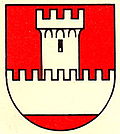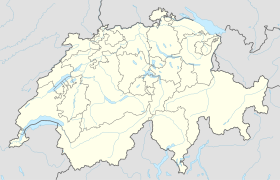Dommartin VD
| VD is the abbreviation for the canton of Vaud in Switzerland and is used to avoid confusion with other entries of the name Dommartin . |
| Dommartin | ||
|---|---|---|
| State : |
|
|
| Canton : |
|
|
| District : | Gros-de-Vaud | |
| Municipality : | Montilliez | |
| Postal code : | 1041 | |
| former BFS no. : | 5517 | |
| Coordinates : | 543 648 / 166 826 | |
| Height : | 730 m above sea level M. | |
| Area : | 2.94 km² | |
| Residents: | 266 (December 31, 2010) | |
| Population density : | 90 inhabitants per km² | |
| Website: | www.dommartin.ch | |
| map | ||
|
|
||
Dommartin ([ dɔ̃maʀtɛ̃ ] or [ dɔmaʀtɛ̃ ], in the native Franco-Provencal dialect [ (a) dɔmarˈtɛ̃ ]) was a municipality in the district of Gros-de-Vaud in the canton of Vaud in Switzerland . On July 1, 2011, Dommartin merged with the municipalities of Sugnens , Naz and Poliez-le-Grand to form the new municipality of Montilliez .
geography
Dommartin is 730 m above sea level. M. , five kilometers east of Echallens and 15 kilometers north-northeast of the canton capital Lausanne (as the crow flies). The village extends at a height west of the Mentue , on the northern roof of the heights of the Jorat , in the eastern Gros de Vaud , in the Vaudois Central Plateau .
The area of the municipal area of 2.9 km² covers a section of the central, higher Vaudois plateau. The wide height of Dommartin is bounded in the east and north by the Mentue, in the west by its side stream Coruz . Both rivers have carved deep valleys into the molasse layers. In the south-west, the Bois de Chavanne forest belongs to Dommartin. East of this forest is on the field Les Auverneys with 773 m above sea level. M. reached the highest point in the community. In 1997, 5% of the municipal area was accounted for by settlements, 35% for forests and trees and 60% for agriculture.
Some individual farms belong to Dommartin. Neighboring communities of Dommartin are Villars-Tiercelin , Poliez-Pittet , Poliez-le-Grand , Naz , Peyres-Possens and Montaubion-Chardonney .
population
With 266 inhabitants (as of December 31, 2010) Dommartin was one of the small communities in the canton of Vaud. 98.3% of the residents are French-speaking, 1.2% German-speaking and 0.4% English-speaking (as of 2000). The population of Dommartin was 245 in 1850 and 207 in 1900. After the population had decreased to 140 by 1970, a rapid population increase with a doubling of the population within 30 years was observed.
economy
Until the second half of the 20th century, Dommartin was a predominantly agricultural village. Even today, arable farming and cattle breeding play an important role in the income structure of the population. A mill and a sawmill had existed on the Mentue since the 17th century. Today there are more jobs in local small businesses and in the service sector (in a landscape architecture company). In the last few decades the village has also developed into a residential community. Many workers are therefore commuters who work in the surrounding larger towns and in the greater Lausanne area .
traffic
Dommartin is off the main thoroughfares, around 1 km from the Lausanne - Thierrens road. Dommartin is connected to the public transport network by a Postbus course that runs from Echallens to Thierrens.
history
The place was first mentioned in documents in 908 under the name Domno Martino villa , derived from Dom Martin , a monk who made the area arable. Dommartin probably developed from a royal estate of Hochburgund . In the 12th century Dommartin, to which all the surrounding towns (except Poliez-Pittet) belonged, became part of the cathedral chapter of Lausanne. The bishop had the settlement, which at that time comprised around 100 fire places, fortified from 1180 to 1190 and granted it extensive freedom.
The gradual decline of Dommartin began with the conflagration of 1235. Although the town was rebuilt, 100 years later there were only around 40 fireplaces. Up until the Reformation, it was the main place of a castlane of the Lausanne cathedral chapter. Numerous witch trials were held in Dommartin during the 15th and 16th centuries.
With the conquest of Vaud by Bern in 1536, Dommartin came under the administration of the Bailiwick of Lausanne . It continued to form a Kastlanei, which also included the towns of Naz, Peyres-Possens, Montaubion-Chardonney, Villars-Tiercelin and Sugnens. Another fire disaster in 1547 destroyed the castle, church and numerous houses. The former settlement on the spur surrounded by the Mentue was then abandoned and Dommartin rebuilt as a village further south on the heights. After the collapse of the Ancien Régime , the village belonged to the canton of Léman from 1798 to 1803 during the Helvetic Republic, which then became part of the canton of Vaud when the mediation constitution came into force . In 1798 it was assigned to the Echallens district.
Attractions
The special octagonal structure (with an extended central axis) of the parish church dates from 1733 to 1735. The rectory, built around 1600, was rebuilt in the 18th century. Some stately farmhouses from the 18th and 19th centuries have been preserved in the town center. The few ruins of the medieval settlement on the spur above the Mentue have been a listed building since 1900.
Web links
- Official website of the former municipality of Dommartin (French)
- Jean-Daniel Morerod: Dommartin. In: Historical Lexicon of Switzerland .
- Aerial photography
Individual evidence
- ↑ Florence Cattin, Dommartin VD (Échallens) in: Dictionnaire toponymique des communes suisses - Lexicon of Swiss community names - Dizionario toponomastico dei comuni svizzeri (DTS | LSG) , Center de dialectologie, Université de Neuchâtel, Verlag Huber, Frauenfeld / Stuttgart / Vienna 2005 , ISBN 3-7193-1308-5 and Éditions Payot, Lausanne 2005, ISBN 2-601-03336-3 , p. 300f.



